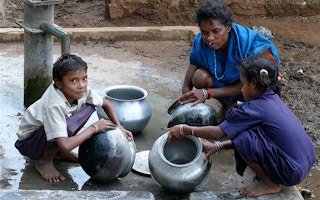Tribal groups in India’s Maharashtra state gather at an ancient shrine before harvest each year to give thanks and celebrate their sacred land by singing, dancing and feasting.
This year, they injected a modern twist: a discussion about the threat of mining on their densely forested landscape. A threat so severe that villagers are displaying a rare show of unity to campaign against exploitation of their hallowed land.
“The forest-dwelling communities have legal rights over jal, jangal, jameen (water, forest, land) where they have been living for generations,” said Mohan Raut of rights group Bharat Jan Andolan, which is backing the villagers’ campaign.
“Why should they give up those rights for mines that will destroy their land and their way of life?”
“
The villagers have not been consulted, they have not been told of the environmental or social impact, as required by law.
Mohan Raut, Bharat Jan Andolan
Natives and Maoists
Largely inhabited by indigenous people, the eastern part of one of India’s wealthiest states has long been coveted for its mineral reserves, be it coal, iron ore or manganese ore. It has also been the hotbed of a decades-long Maoist insurgency.
For long-time residents, though, the hills and forests in the Surjagad range are the sacred source of their history and livelihood. This way of life and subsistence are increasingly under threat as the state makes its big push into mining.
It is a story playing out across the nation.
Conflicts related to land and resources have affected millions of people in India, stalling scores of industrial and development projects and putting billions of dollars of investment at risk, according to a recent report.
While legislation - such as a 2006 forest rights law and a 1996 act on tribal areas - aims to protect the rights of farmers and indigenous communities over their lands, the laws are usually diluted and poorly implemented, activists say.
Now it is the turn of tribal groups in the western state of Maharashtra, already one of the most developed areas in India.
About 25 prospecting licences have been issued to companies to look for minerals, covering more than 18,000 acres (28 sq miles) of land, according to district officials.
Alarmed by the potential destruction, and backed by rights activists, about 70 villages are campaigning against mining.
“The villagers have not been consulted, they have not been told of the environmental or social impact, as required by law,” said Raut. “These are vulnerable people who have lived here for generations. The forests will be decimated by mining, which is why the villages have unusually come together to oppose it.”
Liquor and leaves
Lloyd’s Steel Industries, which received a mining licence in 1993, has had its operations hit by Maoists from time to time.
A company official was killed in 2013, and Maoists torched dozens of the company’s trucks last December.
Maoists claim they are fighting for the rights of poor, indigenous people and say that mining only benefits wealthy firms and the state.
The violence has abated, and prospecting licences have been issued to about a dozen companies, including JSW Steel.
Most companies that have received licences have not done environment or social impact assessments, or held public hearings with villagers who are largely ignorant of the damage that can be caused by mining, Raut said.
A spokesman for Lloyd’s said the company had received “all required approvals after due process”.
A spokesman for JSW Steel said its license was secured “after following the due process of law”.
India’s resource-rich forest land is primarily located in the poorest areas, including some racked by extremist violence . Resources are in high demand to fuel development in one of the fastest growing countries in the world.
In the Surjagad range, tribal communities harvest tendu leaves - used in hand-rolled cigarettes - and other forest products such as honey and the leaves of the mahua tree for a fiery liquor. They also cultivate millet and rice.
Last year, the 70 village councils sent a notice to the state government, asking it to cancel all licences, fearing mining will destroy their place of worship and their tradition.
A district official said all procedures were followed.
“The district has no industry: the mines will generate jobs and growth,” A.S.R. Naik, Gadchiroli’s chief revenue official, told the Thomson Reuters Foundation.
JSW Steel has said its project will generate 172 jobs. Campaigners say these are inadequate, and that villagers anyway lack the skills to benefit.
This story was published with permission from Thomson Reuters Foundation, the charitable arm of Thomson Reuters, that covers humanitarian news, women’s rights, trafficking, property rights, climate change and resilience. Visit news.trust.org to see more stories.










